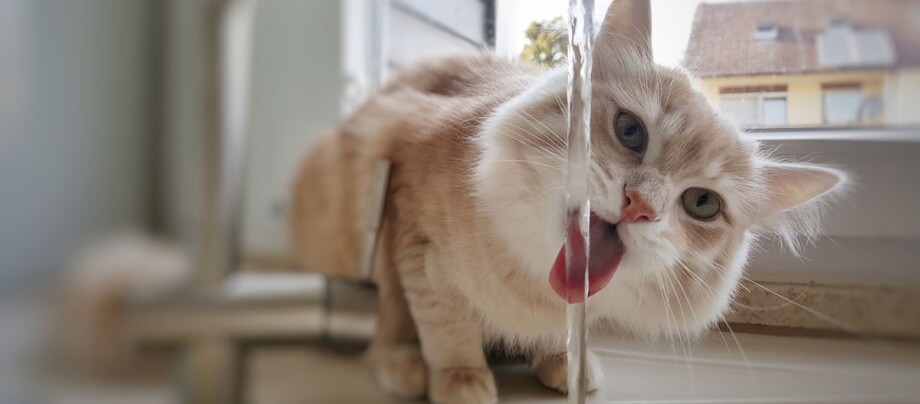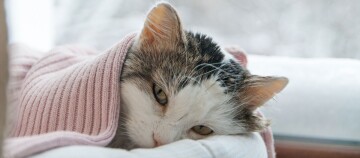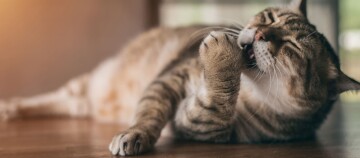Kidney Failure in Cats - Most Common Cause of Death in Senior Cats
23.11.2022 - Reading time: 5 minutes

At the point at which you notice that your cat is suffering from kidney damage, it is already high time to act: The symptoms of kidney insufficiency usually only become outwardly visible once the disease has progressed. In addition to non-specific signs such as fever, faintness, weight loss and avoidance of movement, an extremely increased thirst and the associated frequent visits to the litter tray is a signal that should be taken seriously that something is wrong with the body detoxification of your four-legged friend.
How do my cat's kidneys work?
The cat’s kidneys, surrounded by a fatty capsule, lie to the side of the spine in the lumbar region and are highly effective organs. 200,000 nephrons per kidney filter toxins, by-products from protein breakdown and substances that need to be drained into the urine. Nephrons are functional units within the kidney consisting of renal corpuscles and renal tubules: the corpuscles filter a precursor of urine from the blood, reabsorb water and components valuable to the body, such as glucose and minerals, back into the organism. The toxins that have been sorted out are passed on to the final urine, which is finally excreted. These amazing little sewage works can do even more: they regulate the water and electrolyte balance, contribute to the formation of new blood and keep blood pressure stable.
They also produce hormones and regulate the acid-base balance. The kidneys are therefore central components of the metabolism. If there are problems with these organs, the cat is in acute danger. In the case of renal insufficiency, the nephrons are irreversibly damaged, with the result that the “filters” become more and more permeable and urine poisoning occurs – the medical profession then speaks of “uraemia”. For a while, the body can buffer the damage to the renal corpuscles by forming tissue. It is all the more tragic that the first visible symptoms of kidney insufficiency only appear when the organs are already highly damaged – about three quarters of the original functionality is already lost by then.

How does renal insufficiency manifest itself in cats?
Triggers for kidney problems in cats can be infections, high blood pressure or genetic predisposition. The ingestion of toxic substances – including certain houseplants or heavy metals (lead, mercury) – can also cause severe kidney damage. Mostly, however, the trigger is simply old age: renal insufficiency mostly affects older cats. A distinction is therefore made between chronic kidney disease (CKD), which develops over a longer period of time, and the rarer acute kidney injury (AKI), which was initiated by an external cause or poisoning.
In kidney disease, there is an inflammation of the renal tubules and the intermediate tissue. As, when the kidneys no longer work properly, there is a gradual poisoning of the body, the first symptoms are quite unspecific and actually initially indicate poisoning by an external influence.
As the diseased kidneys are painful, the cat’s mobility is also restricted: it runs, climbs and jumps less; in extreme cases, even taking a small step to the litter tray can become torture. At the latest there, in the advanced stage, another visible effect becomes apparent: the cat’s urine changes colour, smells differently and may contain blood or pus. In addition, the cats react with clear pain when the kidneys are palpated. You should seek veterinary advice at the first sign of poisoning before it progresses.
The following symptoms may indicate poisoning:
- Fever
- restlessness
- faintness
- frequent urination
- incontinence
- shaggy coat, bad breath
- loss of appetite, reluctance to eat
- vomiting
- extreme thirst
- emaciation
How can kidney problems in cats be treated?
Cats over the age of seven should have a kidney check with blood work at least every six months in order to detect problems at an early stage. Based on the creatinine values, a urinary metabolic product, the vet can narrow down a kidney disease in various stages and suggest a therapy. This is all the more important because once damaged, kidney cells can no longer regenerate. However, with an early diagnosis, you as a cat owner can counteract the progressing organ damage.
First and foremost, the change of food plays an important role. The specialised trade is prepared for this and offers kidney diet food for cats. This contains high-quality, balanced proteins and a reduced amount of salt and phosphorus. However, you may have to trick the cat a little to get it used to the tasteless new food. The disease causes the body to lose a lot of water, so the cat must always have enough water available to prevent dehydration. Many cats prefer to drink running water. In order to playfully animate the animal, there are drinking fountains designed for this purpose. Parallel to this, medication can be administered if necessary. Drainage, blood pressure and possible nutrient deficiencies are supported pharmaceutically.
What is the prognosis for renal insufficiency in cats?
Although kidney disease is a common disease in old cats, in rarer cases even young animals can suffer from kidney problems; furthermore, cats such as Burmese, Russian Blue, Maine Coon, Abyssinian and Siamese have a breed-specific predisposition to kidney problems. If the disease is detected at an early stage, possibly even before clinical signs appear, kidney disease can be treated well, even if it is incurable. If the diet is strictly adhered to and the cat’s health status is well monitored by you and the vet, even a cat with kidney damage can grow old without symptoms. However, kidney disease is still one of the most common causes of death in senior cats.



